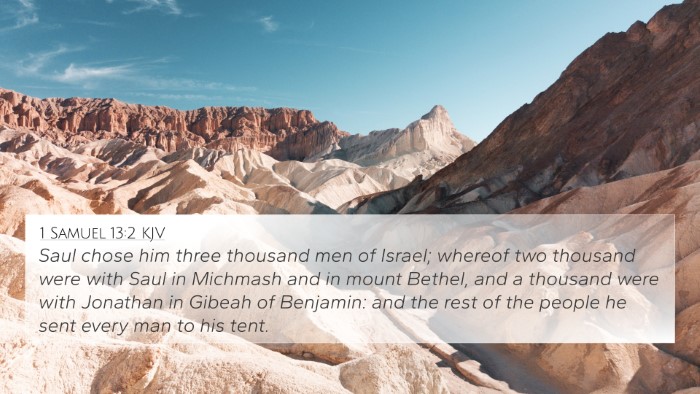Understanding 1 Samuel 13:15
Verse: 1 Samuel 13:15 - "And Samuel arose, and gat him up from Gilgal unto Gibeah of Benjamin: and Saul numbered the people that were present with him, about six hundred men."
This verse occurs at a pivotal moment in the story of Saul, Israel's first king. Samuel's departure from Gilgal symbolizes a significant turning point in Saul's kingship. Notably, public domain commentaries such as those by Matthew Henry, Albert Barnes, and Adam Clarke provide insights into the nuances of this passage.
Key Insights from Commentaries
- Matthew Henry: Henry emphasizes Samuel's role as both prophet and judge, whose departure signifies God's withdrawal of favor from Saul due to his disobedience. Saul's counting of men illustrates a moment of weakness and dependence on human strength rather than divine guidance.
- Albert Barnes: Barnes notes that this event highlights Saul's isolation and the dwindling power of his forces, emphasizing that in times of crisis, true leadership is tested. Saul is left with only 600 men, signifying fear and insecurity.
- Adam Clarke: Clarke elaborates on the symbolic nature of Gilgal, a place of covenant commitment. Samuel's exit from this sacred place implies that Saul is now operating without God's sanction, bringing consequences for the future.
Connections Between Bible Verses
This verse connects with several important themes in the Bible, notably the relationship between obedience to God and His blessing. Below are some critical cross-references:
- 1 Samuel 15:11: God's regret over making Saul king due to his disobedience.
- 1 Samuel 10:8: Samuel's previous instructions to Saul about waiting for him at Gilgal.
- 1 Chronicles 10:13-14: Summary of Saul's disobedience and the result of his attempts to consult God through mediums.
- Psalm 51:11: A plea for God not to cast His presence away, paralleling Saul's loss of divine favor.
- Isaiah 59:2: Highlights how sin separates us from God, exemplifying Saul's plight.
- Luke 12:27-28: A New Testament example of reliance on God rather than human strength.
- Philippians 4:19: Encouragement that God provides for those who are faithful.
- Romans 11:29: Emphasizes that God's gifts and calling are irrevocable, connecting back to God's initial choice of Saul.
- 2 Timothy 3:16-17: Discusses the utility of Scripture for teaching and correction, underscoring the importance of obedience.
Thematic Connections
The themes present in 1 Samuel 13:15 can further be explored by comparing verses that resonate with the ideas of leadership, obedience, and divine withdrawal. This is where Bible verse cross-references become invaluable in deepening our understanding of Scripture. They reveal connections that may not be immediately apparent but are vital for a fuller grasp of God’s message.
Cross-Referencing Biblical Texts
Utilizing a Bible concordance or a Bible cross-reference guide may illuminate significant links. It helps understand how the narrative of Saul connects with the broader themes of faithfulness and disobedience throughout Scripture.
Practical Tools for Cross-Referencing
- Tools for Bible cross-referencing: Utilize resources such as cross-reference Bibles that provide direct links between related scriptures.
- Cross-reference Bible study: Engage in collaborative studies that emphasize verses that highlight similar themes or outcomes.
- Comprehensive Bible cross-reference materials: Explore in-depth studies or books that compile major themes of scripture and compare them across the Old and New Testament.
Conclusion
1 Samuel 13:15 serves as a powerful reminder of the importance of obedience to God's commandments. The fate of Saul, illustrated through this verse, reflects how disobedience leads to despair and loss of divine support. By engaging in cross-referencing Biblical texts, believers today can deepen their understanding of the scripture and cultivate a life aligned with God's will.
Exploring Further
Understanding the connections between Bible verses, like 1 Samuel 13:15 and its related scriptures, enriches our spiritual journey. It illuminates the text, revealing God's overarching narrative of grace, judgment, and redemption.





